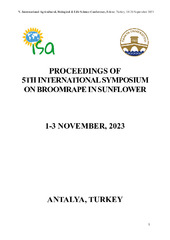Приказ основних података о документу
In the race with the broomrape – Is there a winner?
| dc.creator | Jocković, Milan | |
| dc.creator | Jocić, Siniša | |
| dc.creator | Cvejić, Sandra | |
| dc.creator | Ćuk, Nemanja | |
| dc.creator | Radanović, Aleksandra | |
| dc.creator | Miklič, Vladimir | |
| dc.creator | Jocković, Jelena | |
| dc.creator | Miladinović, Dragana | |
| dc.creator | Dedić, Boško | |
| dc.date.accessioned | 2023-11-21T11:32:01Z | |
| dc.date.available | 2023-11-21T11:32:01Z | |
| dc.date.issued | 2023 | |
| dc.identifier.isbn | 978-625-00-1676-3 | |
| dc.identifier.uri | http://fiver.ifvcns.rs/handle/123456789/4020 | |
| dc.description.abstract | Broomrape (Orobanche spp.) is a widespread, herbaceous, parasitic plant that has been known to attack various host plants, including sunflower (Helianthus annuus L.). It is native to regions in Europe and Asia, and it co-evolved with various host plants and with the expansion of agriculture and the movement of crops around the world, broomrape was unintentionally transported to new areas. Newer studies reports about sunflower broomrape detection in African countries such as Tunisia and Morroco. After the discovery of broomrape infestations on sunflower, various control and management strategies have been developed to combat its spread which includes crop rotation, use of resistant sunflower genotypes, herbicide use and other cultural practices aimed at reducing the prevalence of broomrape. Since it appereance on sunflower in the beggining of the 20th Century and development of resistant sunflower varieties, broomrape control was mostly focused on using resistant genotypes with monogenic inheritance. With the expansion of resistant sunflower genotypes in the production, existential pressure on broomrape led to the emergence of more virulent physiological races. Broomrape races are designated with letters, from A to H, and until the middle of 1990s broomrape race E was predominant in the most countries were broomrape was present and was successfully controlled by resistant gene Or5. However, studies from the last several years indicate disimilarities between broomrape populations with the same letter (above race E) reported in different countries. Newer molecular studies are focused on detecting quantitative trait loci (QTLs) which may act at different development stages of broomrape, providing accumulative resistance mechanisms in order to ensure more durable protection. Despite efforts to control broomrape, it remains a persistent problem in sunflower cultivation in certain regions. New strains of broomrape may emerge, making control measures an ongoing challenge for breeders and farmers. Research and development efforts are ongoing to find more effective and sustainable ways to manage this parasitic plant and protect sunflower crop. | sr |
| dc.language.iso | en | sr |
| dc.publisher | Edirne : Trakya University | sr |
| dc.relation | info:eu-repo/grantAgreement/MESTD/inst-2020/200032/RS// | sr |
| dc.relation | info:eu-repo/grantAgreement/ScienceFundRS/Ideje/7732457/RS// | sr |
| dc.relation | info:eu-repo/grantAgreement/EC/HE/101059784/EU// | sr |
| dc.relation | Climate Crops - Centre of Excellence for Innovations in Breeding of Climate-Resilient Crops, Institute of Field and Vegetable Crops | |
| dc.rights | openAccess | sr |
| dc.rights.uri | https://creativecommons.org/licenses/by/4.0/ | |
| dc.source | Proceedings, 5th International Symposium on broomrape in sunflower, 1-3 November 2023, Antalya | sr |
| dc.subject | sunflower | sr |
| dc.subject | broomrape | sr |
| dc.subject | races | sr |
| dc.subject | quantitative trait loci | sr |
| dc.title | In the race with the broomrape – Is there a winner? | sr |
| dc.type | conferenceObject | sr |
| dc.rights.license | BY | sr |
| dc.citation.epage | 14 | |
| dc.citation.spage | 13 | |
| dc.identifier.fulltext | http://fiver.ifvcns.rs/bitstream/id/9779/bitstream_9779.pdf | |
| dc.identifier.rcub | https://hdl.handle.net/21.15107/rcub_fiver_4020 | |
| dc.type.version | publishedVersion | sr |


